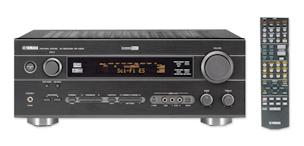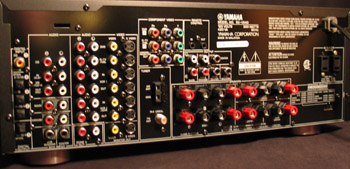|
|||||||||
|
Introduction Yamaha has been in the AV Receiver business for as long as most of us can remember there being such a business. In the Pro Logic hey day, Yamaha was offering equal power to the front three channels when others were still shortchanging us with as little as 10 watts to the center speaker. They were among the first to do Pro Logic decoding in the digital domain, setting a precedent for the analog to digital to analog path which is so critical, continuing to this day. We at Secrets have always had confidence in Yamaha receivers, at very least from the power amplifier perspective. The units have always been well built and able to drive a decent amount of current through a speaker. The present review focuses on the Yamaha RX-V640, a very affordable surround sound receiver at $499 MSRP USA, especially when you consider that it has six channels of amplification. Remember when receivers only had Pro Logic, a couple of DSP modes, and cost almost $2,000? A/V receivers of today are tremendous bargains by comparison. Features In terms of I/O, the V640 does not disappoint with 6 stereo inputs (4 with video), which includes a phono input, and 4 digital inputs which are re-assignable. This is good because otherwise the one and only coax digital input would be bound to CD, ironic since traditionally Yamaha has put only optical digital outputs on their CD players. Two component video lines, an optical digital output, and a 5.1 analog input set are all there. Pre-outs for all channels are provided. Antenna terminals and IR in/out jacks round out the back panel.
Yamaha has for decades now been doing what they call DSP and/or Cinema DSP (Digital Soundfield Processing). This was one of the first systems to "simulate" various acoustic environments like the echo of a cathedral or the immediacy of a jazz club by applying a complex mix of reverb/decay algorithms, developed using acoustic data from actual venues. I (Brian) for many years was the proud owner of several Yamaha receivers. It is fun to once and awhile pipe some Mozart through the Concert Hall mode, but the movie modes just don't "work". To understand why you have to first understand what exactly CinemaDSP is doing. Like the music venues, CinemaDSP takes the decoded soundtrack and simulates the reflections found in a large movie theater (and from what it ends up sounding like, an acoustically live one). Literally, a sound which is in the right surround for example can be heard a fraction of a second later from the left surround and to a lesser extent the left front and to an even lesser extent the right front. If you use the test "clicks" on AVIA, made specifically for this purpose, it really does sound like you are in a highly reflective room. Where CinemaDSP falls apart completely is with that one most important piece of the movie soundtrack: Dialogue. It would compromise intelligibility if a conversation were being bounced all over the place. For this reason, the center channel has no DSP applied to it whatsoever. Although that seems like it would do the trick, it fails when anything is panned across the front stage. The sound will have reverb, then suddenly come into focus as it hits the center channel, and reverb again as it continues on. It's more distracting than if the center channel had the same reverb applied to its signal. Lately, Yamaha has been adding a new parameter to its DSP modes, called Effect Gain. In the V640 you can actually attenuate the simulated reflections, making the modes marginally more believable and useful. The build quality is commensurate with the price point. There is a rigid embossed bottom plate which is responsible for the overall structure of the piece, and it has the usual thin metal cover. I judge the majority of the weight to be in the transformer, as when you lift it, all the weight is right there at that side. In terms of surround decoding, the V640 has everything you'd expect, including Pro Logic II, Dolby Digital EX, DTS ES (but not 24/96), and DTS Neo:6. Function The RX-V640 User Interface (UI) is, like its larger cousin, the RX-Z1, not very intuitive. This is only marginally helped by having a TV connected for the sake of the On Screen Display of the menus. In the V640, Yamaha has given us what they call a "basic" menu, which in our opinion should not be used, at least if a person is interested in getting the most out of their home audio system. The Basic Menu will ask you several questions, one about the size of your room (with three arbitrary choices of small, medium, large), the number of speakers you have, and then gives you the opportunity to adjust the level of each speaker. The Basic menu makes assumptions about speaker distance, crossover settings, and bass redirection, and if you set these things as you should in the "Advanced" menus, and then accidentally enter the "Basic" menu, you'll mess up all your work. So, be careful. Although the volume is the digitally controlled analog type, Yamaha left out a few things that they could have included. There is no option to choose a power-on volume level, nor is there any means of setting a max volume setting. There is a choice for -20 dB, -50 dB, or full cut on the mute, but inputs do not have any sort of level trim. The numbers on the volume scale are totally arbitrary. In other words, having the volume at "-20 dB" is only relative to the top of the volume's own scale. One can of course figure out what reference corresponds to but it would have been dead simple for Yamaha to have scaled the number and allow us to set all speaker levels relative to it. [Editor's Note: All of Yamahas brand new THX AV Receivers get this right]. Each pair of speakers can be set to "Large" or "Small" (center and surrounds can also be set as "None"). The crossover is a fixed set of slopes at 90 Hz. While we don't advocate deviating far from 80 Hz, we know people want choice here. In addition to tones for the 6 main channels, the V640 provides a rumble tone for the subwoofer. There is of course an LFE trim adjustment which is common to both Dolby Digital and DTS (we'd rather it were two settings). The trim has two values: One for when speakers are in use, and another for when headphone are in use. This sounds like a good idea since headphones can easily be overwhelmed with bass, but when down-mixing Dolby Digital 5.1, the LFE channel is supposed to be discarded anyway. In addition, the headphones have their own DRC (Dynamic Range Control) setting. We were delighted to see a 5 band EQ for the center channel. We just wish there were EQs for at least the other front channels and especially the subwoofer. There is no A/V Sync delay setting. Master time alignment can be set by inputting feet or meters, and the V640 sets everything up right. The front panel offers four levels of illumination.
Speaking of Zone2, the V640 is one of the least expensive two-zone units you will find with amplification for the second zone. It is a true Zone2 with separate power, volume, and source selection. The V640 uses the knob concept on its front panel for input selection. Also on the front are controls for the radio, DSP mode selection, and knobs for bass/treble. There are buttons for selecting the 5.1 input, and there is also a handy input set on the front that includes stereo audio, optical digital audio, and composite/S-Video. The six-channel input is a pure analog feed. There is no option to digitize it for the sake of bass management or time alignment. Sound Yamaha quotes the power from all channels as being 85 watts into 8 ohms, 20 Hz -20 kHz with 0.06% THD. That's good but they don't qualify that with a number of channels driven, and in our Bench Tests (see below) we found that it came up shorter than that. Still, in practice, it's not bad, especially if the speakers are at all reasonably efficient. High pass everything, use a proper subwoofer, and this unit should be adequate for most smaller home theaters. And that is exactly what we found in our listening tests. This little receiver is a tremendous value. Brian found that the sound does not have the brightness we are used to from Yamaha, while offering power that belies its little frame. Sandy still felt it was a little edgy but nothing we could really complain about at this price point. Click Here to Go to Part II - On the Bench and Conclusions
|
|||||||||


 We were
a little
disappointed, even at its $499 price point, to see that the RX-V640 has only one line
out and speaker out for the center surround (a.k.a. rear) channel.
Although Dolby does not expressly require it, in our listening experience,
two speakers are a must for the center surround. True you can run a pair of speakers in
parallel, showing the V640 as much as 16 ohms (not a problem), but if Yamaha
had gone with two amps instead of one, they could have done some interesting
things like given a choice of where to route the surrounds of a 5.1 source:
the sides, rears, or both. A pre-out for the second center surround would
have been OK as well.
We were
a little
disappointed, even at its $499 price point, to see that the RX-V640 has only one line
out and speaker out for the center surround (a.k.a. rear) channel.
Although Dolby does not expressly require it, in our listening experience,
two speakers are a must for the center surround. True you can run a pair of speakers in
parallel, showing the V640 as much as 16 ohms (not a problem), but if Yamaha
had gone with two amps instead of one, they could have done some interesting
things like given a choice of where to route the surrounds of a 5.1 source:
the sides, rears, or both. A pre-out for the second center surround would
have been OK as well. The Remote Control at first
glance is a fairly typical all-in-one with codes for most major brands of
home A/V electronics. After sitting down with it for a while, I felt it is one
of the best basic remotes I've seen with an entry level receiver.
There are separate volume buttons for the TV, cursor, and transport
buttons available at the same time for the DVD player, and
controlling Zone2 is a snap. The only improvement which could be made
is to vary the size or shape of the buttons a little, especially on the
cursor pad.
The Remote Control at first
glance is a fairly typical all-in-one with codes for most major brands of
home A/V electronics. After sitting down with it for a while, I felt it is one
of the best basic remotes I've seen with an entry level receiver.
There are separate volume buttons for the TV, cursor, and transport
buttons available at the same time for the DVD player, and
controlling Zone2 is a snap. The only improvement which could be made
is to vary the size or shape of the buttons a little, especially on the
cursor pad.

